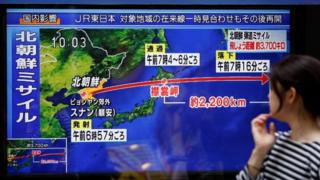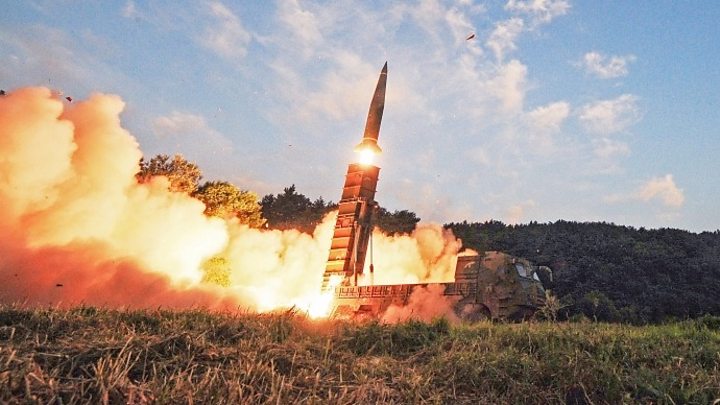VIDEO - North Korea fires second ballistic missile over Japan - BBC News
 Image copyright Reuters Image caption A passer-by in Tokyo looks at a TV screen reporting news about North Korea's missile launch
Image copyright Reuters Image caption A passer-by in Tokyo looks at a TV screen reporting news about North Korea's missile launch North Korea has fired a ballistic missile across Japan, creating new tension in the region after its nuclear bomb test less than two weeks ago.
The missile reached an altitude of about 770km (478 miles), travelling 3,700km before landing in the sea off Hokkaido, South Korea's military says.
It flew higher and further than one fired over Japan late last month.
Japanese Prime Minister Shinzo Abe said his country would "never tolerate" such "dangerous provocative action".
South Korea responded within minutes by firing two ballistic missiles into the sea in a simulated strike on the North.
US Secretary of State Rex Tillerson also condemned the launch and the UN Security Council will meet later on Friday in New York at the request of the United States and Japan.
Why does this new test matter?
The launch took place from the Sunan district of the capital Pyongyang just before 07:00 local time (22:00 GMT on Thursday), South Korea's military says.
Sunan is home to Pyongyang International Airport, 24km north of the city centre.

Media playback is unsupported on your device
Media caption North Korea missile triggers Japan warning alarmsAs with the last test on 29 August, the missile flew over Japan's northern Hokkaido island before splashing down in the Pacific Ocean. There were no immediate reports of damage to aircraft or ships.
Sirens sounded across the region and text message alerts were sent out warning people to take cover.
| Comparison of missile launches over Japan | ||
|---|---|---|
| 15 September | 29 August | |
| Distance travelled | 3,700km (2,299 miles) | 2,700km |
| Maximum altitude | 770km | 550km |
| Landing distance from Japan | 2,200km | 1,180km |
| Flight duration | 19 minutes | 32 minutes |
| Missile type | Thought to be intermediate range missile | Thought to be intermediate range Hwasong-12 |
Observers say it is likely to have been an intermediate range ballistic missile (IRBM) though Japanese officials believe there is still a possibility it was an intercontinental ballistic missile (ICBM).
What is so alarming about the new launch is that the US Pacific territory of Guam, which North Korea says it has plans to fire missiles towards, is 3,400km from Pyongyang, putting it within range of the latest missile.
Sanctions on the North were tightened this week in response to its sixth nuclear test on 3 September, which reportedly involved a miniaturised hydrogen bomb that could be loaded on to a long-range missile.
How will the international community respond?
After the latest round of sanctions, it is not clear what other course of action is open to the UN Security Council.
Only on Monday, the Security Council voted unanimously to restrict oil imports and ban textile exports, in an attempt to starve the North of fuel and income for its weapons programmes.
Mr Tillerson put the burden of response to the latest test on China and Russia, the North's main economic partners.
They "must indicate their intolerance for these reckless missile launches by taking direct actions of their own", he said.
He said that China supplied North Korea with most of its oil, while Russia was the largest employer of North Korean forced labour.
What was the reaction from China and Russia?
Chinese foreign ministry spokeswoman Hua Chunying said her country was not the "focal point of the conflict".
"The various directly involved parties should take responsibility," she added, in remarks that appeared aimed at the US and South Korea. "Any attempt to wash their hands of the issue is irresponsible."
Ms Hua called for a peaceful solution "through formal diplomatic means".
Russia's foreign ministry condemned North Korea's "illegal" test, but added: "Regrettably, aggressive rhetoric is the only thing coming from Washington."
Have North Korea's missile tests paid off?
How is South Korea responding?
In South Korea, President Moon Jae-in held an emergency meeting of his national security council, where he said that dialogue with the North was "impossible in a situation like this".
Image copyright EPA Image caption South Korea tested missiles in response to the North's new launchOfficials have been ordered to prepare for possible North Korean chemical, biological and electromagnetic pulse (EMP) attacks, a presidential spokesman said.
North Korea has said it has bombs capable of sending EMP shock waves, which would disrupt power supplies, although the claim has been greeted with some scepticism.
The country does have an extensive chemical arsenal and may also have biological weapons.
Why is the North acting like this?
It insists it needs a nuclear-weapons programme to ensure its survival and there has been no let-up in its fiery rhetoric.
On Thursday, it threatened to "sink Japan and turn America to ashes".
Image copyright Reuters/KCNA Image caption North Korea said in early September that it had tested a "missile-ready" hydrogen bombA commentary in North Korea's state-run Rodong Sinmun newspaper after the missile launch accuses the US and South Korea of conducting "ceaseless" exercises as a provocation.
North Korea's missile programme

Media playback is unsupported on your device
Media caption How would war with North Korea unfold?- Pyongyang has been developing weapons, initially based on the Soviet-developed Scud, for decades
- Conducted short and medium-range missile tests on many occasions, sometimes to mark domestic events or periods of regional tension
- Pace of tests has increased in recent months; experts say North Korea appears to be making significant advances towards building a reliable long-range nuclear-capable weapon
- On 3 September, North Korea said it tested a hydrogen bomb that could be miniaturised and loaded on a long-range missile
Pushing the envelope
Rupert Wingfield-Hayes, BBC News, Tokyo
Image copyright KCNA Image caption North Korea's rocket launch last month was described by Japan as an "unprecedented threat"This test came as a surprise to nobody.
North Korea is steadily proceeding down the path to full ICBM capability. To do that, it needs to test-fire its projectiles - every other missile-armed nation has done the same.
It started earlier this year by firing its new longer-range Hwasong missiles into the Sea of Japan, then flew one over Hokkaido in August. Next it tested a powerful nuclear device, which it claims it can put on a missile.
Now it has tested another intermediate range missile at longer range and higher altitude.
The next step will almost certainly be a test of the Hwasong-14 ICBM over Japan and far out into the Pacific.
The aim of all this is to develop and deploy a reliable missile that can hit the mainland US.